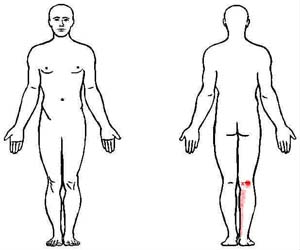
Gastroc Trigger Points
Gastrocnemius Trigger Points Cause Achilles Pain
The Achilles tendon is a fusion of two muscles, the gastrocnemius and the soleus muscles. These two strong powerful muscles fuse to form one common calcaneal tendon, also known as the Achilles tendon. The calcaneal tendon inserts on the calcaneus bone. Soleus and gastrocnemius muscle contraction produces plantar flexion.

We have to utilize the gastrocnemius and soleus muscles when we walk and run. They also absorb stress from standing. Over time these muscles tend to tighten and become tender. If they continue to be overworked it leads to trigger points near the muscle origin.
Trigger points in the gastrocnemius radiate from the posterior knee down to the calcaneus. Early stages of the trigger point are often misinterpreted as muscle soreness. As people continue to run the increased trauma and damage to the gastrocnemius muscle leads to more serious sprains and strains.
Runners often experience gastrocnemius trigger points when they increase their mileage or begin running up or down Hills. The extra stress load on the gastrocnemius leads to running injuries.
Conservative Treatments
Therapeutic treatments for addressing soft tissue injuries involve massage therapy, manual therapy, trigger point therapy, Graston Technique, or Active Release Technique. These treatments increase blood flow, decrease muscle spasms, enhance flexibility, speed healing, and promote proper tissue repair.
When these treatments are incorporated into a treatment plan patients heal faster and are less likely to have long-term pain or soft tissue fibrosis or scar tissue in the injured muscle. These soft tissue treatments are incorporated with therapeutic exercise and flexibility programs.
Medical Treatments
NSAIDs are often prescribed for the initial acute injury stages. In severe cases that involve multiple joint regions, muscle relaxers or oral steroids can be given. Trigger point injections, botox, or steroid injections can be treatment options. Pain management is not usually required unless stronger medications or joint injections are required for treatment.
MRI and X-rays will not usually be ordered to evaluate mild to moderate muscle, tendon, and ligament injuries. Severe cases may utilize advanced imaging to rule out bone fractures, edema, nerve entrapments, tendon or muscle ruptures. NCV testing may be utilized in cases that also involve muscle, sensory, or reflex loss.
Sciatica is the term for radiating pain down the leg. Most commonly it comes from the back and radiates down the leg. Several back injuries and nerve entrapment injuries can cause sciatic pain in the leg. The pain patterns from a lumbar disc, lumbar joint sprain, sacroiliac sprain, or piriformis syndrome produces different patterns of radiating pain than trigger points. Proper identification of the pain pattern, along with reproduction of pain from palpation of the trigger point allows the provider and patient to feel comfortable with the diagnosis.
Likewise many trigger point injuries are associated with poor joint stabilization in the foot, knee, or hip. This leads to poor alignment and excessive forces being placed onto muscles and tendons. Iliotibial band Syndrome is common in runners who develop the injury because of weakness and poor stabilization of the leg and hip muscles. These runners will also have multiple trigger points in the quadriceps, psoas, gastroc, soleus, and gluteus medius.
Your chiropractor, physical therapist, occupational therapist, or physician will evaluate your condition and make a proper diagnosis and treatment recommendations. Ask them any questions you might have about your injury.
Conclusion
The lower extremity works as a comprehensive unit performing many of the repetitive tasks at home, work, and recreational sports. Injuries to one area of the musculature often indicate that additional damage has been incurred by other muscles.
Many therapeutic exercises can help restore proper strength and endurance to the leg muscles muscles. Isometric exercises are often the initial treatment exercises. Followed by single plane rubber band exercises for hip, knee, and ankle; flexion, extension, adduction, abduction, circumduction, inversion, and eversion. Dynamic exercises involving stability foam, rubber discs, exercise ball, and BOSU balls can be performed on the floor. The more unstable of the surface the more effort and stabilization is required of all the lower extremity muscles.
Vibration plates enhance neuromuscular learning throughout the ankle, knee, foot, hip, and back muscles. Additional strength exercises can be found on the hip, knee, and foot strengthening pages. More information for injuries and treatments for knee pain and foot pain.
Our Chandler Chiropractic & Physical Therapy clinic treats patients with a variety of muscle, tendon, joint, and ligament injuries. The clinic provides treatment for runners, tri-athletes, and weekend warriors in addition to common headache, neck, and back patients traditionally seen in Chiropractic, Physical Therapy, Massage Therapy clinics. We work with all ages and abilities of the residents in Phoenix, Tempe, Gilbert, Mesa, and Chandler AZ.